APRENDIZAJE COOPERATIVO II : NORMAS Y ROLES

Retomando la disposición en el aula de la que estuve hablando en el primer post sobre Ap. Coop no quiero que se me olvide decir que hay cuatro premisas que se deben tener en cuanta a la hora de disponer el espacio para la cooperación: 1. PROXIMIDAD (Los miembros de un grupo deben sentarse juntos, de forma que se puedan mirar a la cara, compartir los materiales, hablar entre ellos sin molestar a los demás...) 2. MOVILIDAD (Los grupos deben estar lo bastante separados como para que no interfieran unos con otros y para que el docente tenga despejado el camino hacia cada equipo. Los alumnos deben tener un fácil acceso a los demás, al docente y a los materiales que necesitan) 3. VISIBILIDAD (Los miembros de un grupo deben poder ver al docente en el lugar en el que realiza las explicaciones sin taner que adoptar una posición incómoda) 4. FLEXIBILIDAD (Hay que tener previstas las distintas disposiciones y buscar la forma más racional de colocar el aula de cara a facilitar cambios de estru...




